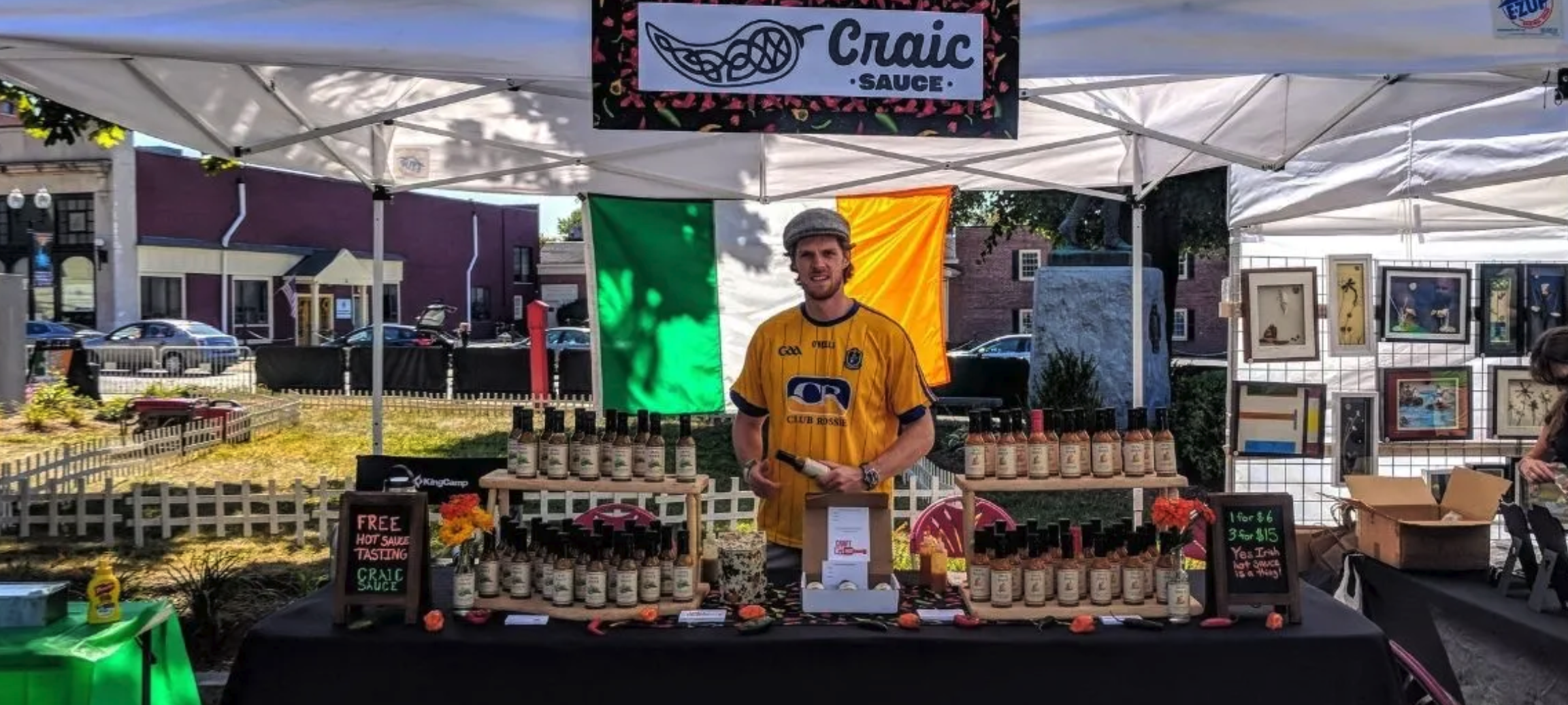Interview with Brian Ruhlmann
By Nina Livingstone
In the 1980s, the heart of Harvard Square was where cultures collided, and diversity emanated from its cafés, restaurants, bookstores, and bakeries. It was also where I discovered my taste for the exotic.
My first brush with curry, cayenne, cumin, and coriander was at an Indian restaurant. I was on a first date. Up to that point, Russia’s cheese, bread, and caviar were as far afield as I had gone. When we were ushered inside, I could smell the trays laden with spicy dishes as they exited the kitchen. My date watched me scan the menu. I was clueless but willing. Then the food arrived.
I dug in. I stopped. I stared straight ahead.
“Are you okay?” my date asked.
I could feel the tears and mascara streaking my cheeks black. I blinked. I blinked again. Beads of sweat formed above my brow.
“Oh yes, I am fine,” I said. “This is hot, umm … very spicy!”
I wiped my eyes. My nose dripped past my lips. I blushed. I blew my nose. I felt the sudden and impressive clearing of my sinuses. My watery eyes and runny nose had transformed me. I wanted more. I came back three days later! The relationship grew, and so did my choice of spicy dishes! I learned what to sprinkle and spritz across each one. But I wanted to know more, so I began my search. While India didn’t have a hot sauce, per se, Germany, Denmark, and Finland did. Jamaica came as no surprise, and Ireland made the top 10 in one of the many lists I found online.
Americans’ love of hot sauce has also grown exponentially. Brian Ruhlmann, the maker of Craic Sauce, wants to explain why the heat is here to stay.

Photo Credit: Craic Sauce
Q: When was the first time you tasted hot sauce? Did that trigger your passion for making a career out of it?
I probably had my first hot sauce (Jalapeño Tabasco) around the age of 9 or 10. My dad would always have a full cabinet of it, and I loved the unique sweet and sour flavor it would bring to home cooked meals.
I never planned to make a career out of hot sauce or food. My employer in 2014, HubSpot, made me start a website, blog, and newsletter for a month-long project about any topic. I wrote about craft hot sauce because I made hot sauce 4 or 5 times the month before when I had a surplus of peppers from my dad’s garden. When I started interviewing hot sauce makers and chili growers during this month-long onboarding project, I ended up being super curious and interested in people’s unique approach and connection to making hot sauce. I decided to continue podcasting, researching, and writing about craft hot sauce for my own personal enjoyment. It was three years later, when I arrived back home, that I was inspired to start Craic Sauce.
Q: What makes your hot sauce special?
We make hot sauces that you can use for every single meal, so it’s all about flavor for us. We believe that our hot sauces are among the best because we grow our own ingredients or source them from local farms. We cook two of our sauces low and slow, so the onions, garlic, ginger, and carrots caramelize, and then our two other sauces are fermented for over a year before we blend them up, which produces amazing umami flavors you can’t get otherwise. Sourcing local and doing long-age ferments isn’t the easiest approach, but we do it because we love every step of the process and it makes the best tasting and healthiest products possible.

40 Shades of Green Chili Ingredients, Credit: Craic Sauce

Fermented Chili Mash, Credit: Craic Sauce
Q: You’ve spoken of your father’s garden. What did he grow, and how did that influence you?
My dad has had a garden since I was born. Every year we’d grow raspberries, strawberries, asparagus, zucchini, kiwis, lettuce, pumpkim, tomatoes, and basil, but we’d also experiment with more unique foods like specialty peppers or pawpaws (editor’s note: the papaw is a tree native to North America that bears a large fruit we’re told tastes like a cross between a mango and a banana). Almost every meal at home would include something from the garden. My favorite is a sweet Sungold tomato sauce we’d make and freeze so we could enjoy it over the whole year.
I didn’t consider myself an avid gardener growing up, but I would spend a lot of time outside, eating things off the vine, and picked up lots of tricks from my dad over the years. I think seeing the whole process of picking tomatoes to make a sauce and then eating it is something that I may have subconsciously thought about when deciding to make hot sauce.
In 2014, we decided to grow habanero and golden ghost peppers. After eating one, I realized that they were too hot to eat straight, which is why and when I first experimented making a hot sauce. Hutchins Farm has a plot that’s right next to ours, so I got pumpkins from them that I roasted and added to the peppers, which evolved into our Golden Pumpkin hot sauce recipe.

Photo Credit: John Doe
Q: Craic Sauce is a signature hot sauce you created while living in Ireland. Is there anything that makes your products particularly Irish?
I was born and raised in Boston, but my mom’s whole side is from Ireland, and I have lots of cousins there. I was always excited when they visited; hearing stories about growing up there, the sports, and just fun conversations that would last all night. I have my Irish citizenship, so when I was in college, I went abroad to University College Dublin, and then I worked and lived in Ireland for a few years.
I wouldn’t say there’s anything particularly Irish about the ingredients or the hot sauce itself, but our brand and values have a lot to do with my Irish heritage and experiences. “Craic” (pronounced “crack”) is an Irish word for good times or fun, and we find that food can be central to those good times, so we’re creating a great hot sauce that you can enjoy with good company or invite strangers to share a bottle of at a local pub or restaurant or BBQ. I would also say that our hot sauce goes great with traditional Irish foods like shepherd’s pie, an Irish breakfast, or roasted vegetables. A lot of people joke with me at the farmers markets that Irish food is very bland and not good, but I wholeheartedly disagree.
Q: Did it take you long to decide on “Craic” as your product’s name?
I had been interviewing and meeting hot sauce makers all over the world from 2014, and I found the ones I was most interested in and enjoyed the most had a story or deeper cultural connection to their craft. I’ve always felt such a deep connection to Ireland and thought having good craic was exactly the reason why I wanted to start a hot sauce company. I thought I wasn’t going to be able to use the name since I wouldn’t be able to trademark it and went back to the drawing board briefly, but I ended up getting the trademark and we’ve been having great craic ever since.
I actually put together a podcast about our trademark journey.
Q: What ingredients make your sauces different from a traditional Mexican or Asian hot sauce?
We use over 40 ingredients between our four sauces and have 23 ingredients in just our mild verde hot sauce, 40 Shades of Green Chili, so we blend a lot of different styles together. Some regional hot sauces are very specific in style, like Louisiana style, which is fermented cayenne with just vinegar and salt. Sriracha is a south-east Asian style sauce which is blended red chili peppers, garlic, and a little sugar. When making hot sauces, I think about what foods the sauce would complement or even transform and start with that. All of our four sauces have a savory base of onion, garlic, ginger, and carrot.
Q: What’s your hottest selling product?
It’s funny how at the end of the year, for every single year, the sales are almost equally split. At farmers markets, the Golden Pumpkin (our first sauce) is the best seller. The Mill City Red is the best seller in our hometown of Lowell. And the 40 Shades of Green Chili is always most popular among people getting into hot sauce since it’s very approachable and versatile. The curry isn’t for everyone, but people that love unique sauces or curry flavors find that one is their favorite.

Lineup of Craic Sauce at Alpine Butcher in Lowell, MA, Credit: Craic Sauce
Q: How did you fare during the pandemic?
I went full time into Craic Sauce two months into the pandemic. I was fortunate enough to have built a good base by working on it on nights and weekends for two and a half years beforehand. In those two years, I learned a ton about cooking and food safety, took certifications to get my hot sauce ready to sell in stores, and built out accounting, marketing, finances, and sales operations. The sales piece always came naturally for me since I’ve been in sales as my profession since I was selling Celtics tickets as my first job. When I put my full attention to it, we grew pretty quickly, and the local community was super supportive.
Local businesses in Lowell like Gormley’s Cafe, Navigation Brewery, Alpine Butcher, and Purple Carrot were my first stores [to carry Craic Sauce] and helped me really get going. I also went through a business accelerator program with 15 other local Lowell and Lawrence businesses called EforAll, which was so helpful. A big lesson and theme were that I needed to slow down before I could speed up. I really thought about what problem am I solving with Craic Sauce and how do I differentiate, and I did lots of research and planning. I thought I had it all figured out before I started, but I felt very comfortable taking a big step forward in growth after graduating from the program.
Q: What has been the most challenging part of this process?
The most challenging part of everything we do is the intensive harvest season. Planning, organization, and hard work is critical. Since day one, we’ve sourced all our peppers locally, so I need to plan how many bottles I’m going to sell in the next year, and then I need to harvest or source all the peppers from August until the first frost comes. It’s not the easiest approach, and it doesn’t scale if you want to become a national brand. Still, we want to continue making the best and most local product possible and are okay with staying smaller so that we can be closer to every piece of the business, from our direct customers at markets to our growers, store partners, and other partners we work with every day.
“We want to continue making the best and most local product possible and are okay with staying smaller so that we can be closer to every piece of the business.”
Q: What are the three dishes you think demand an excellent hot sauce to make them complete?
Roasted vegetables should always be marinated with Craic Sauce! Salt, pepper, and a little hot sauce, and they just burst with flavor. Bagels and cream cheese need some hot sauce to add a tangy kick. Mexican food—so many possibilities to explore. I have a really hard time eating Mexican food without spice and hot sauce.
Q: Do you have a favorite meal to make with your hot sauces?
Roasted salmon using hot sauce and honey as a glaze.

Credit: Craic Sauce
Q: Anything else you’d like to add or let people know?
Before Craic Sauce, I started CraftHotSauce.com as a passion project in 2014. Since then, it has evolved into a podcast, monthly newsletter, and hot sauce marketplace with 200 of the most unique, independently owned hot sauces. We’ve published over 200 maker stories informing food and spice enthusiasts about different flavors, peppers, and cooking techniques, and our podcast features conversations with hot sauce makers and farmers from all over the world.
Take our flavor quiz to get matched up with the hot sauces you’re most likely to love, and check out the Craft Hot Sauce Podcast.
This interview was originally published on August 11th, 2021 on New England Doorstep Market.








